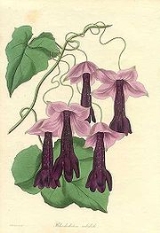
Rhodochiton
Encyclopedia
Rhodochiton is a genus
of flowering plant
s within the family Plantaginaceae
. There are three species in this genus, the most commonly grown is R. astrosanguineum, (syn. R. volubile) the purple bell vine. Native of woodland in Mexico, this attractive plant scrambles through the undergrowth and produces dark purple tubular flowers within a long lasting, papery calyx. Propagation is by seed or cuttings. The two other species, sometimes included in Lophospermum are R. hintonii and R. nubicola.
Rhodochiton atrosanguineus is also known as Rhodochiton volubilis meaning purple bells in the vernacular
, and in the UK it is sometimes colloquially known as the Black Man's Willy due to its appearance. It climbs to circa 3 metres with a 3 metre spread, and has down-covered, heart-shaped leaves, often with purple veining. The rosey-purple, bell-shaped, flowers are produced in early to mid-summer. The bell is formed by five fused sepals while the petals form the tubular purple-black, protruding centre. It flowers annually outdoors with flowers sustaining over a long period in suitable conditions, such that it can be perennial in a conservatory.
It is traditionally classified in the family of 'Scrophulariaceae'.
Genus
In biology, a genus is a low-level taxonomic rank used in the biological classification of living and fossil organisms, which is an example of definition by genus and differentia...
of flowering plant
Flowering plant
The flowering plants , also known as Angiospermae or Magnoliophyta, are the most diverse group of land plants. Angiosperms are seed-producing plants like the gymnosperms and can be distinguished from the gymnosperms by a series of synapomorphies...
s within the family Plantaginaceae
Plantaginaceae
Plantaginaceae Juss. or plantain family, are a family of flowering plants in the order Lamiales. The type genus is Plantago L..In older classifications it used to be the only family of the order Plantaginales, but numerous phylogenetic studies, summarized by the Angiosperm Phylogeny Group, have...
. There are three species in this genus, the most commonly grown is R. astrosanguineum, (syn. R. volubile) the purple bell vine. Native of woodland in Mexico, this attractive plant scrambles through the undergrowth and produces dark purple tubular flowers within a long lasting, papery calyx. Propagation is by seed or cuttings. The two other species, sometimes included in Lophospermum are R. hintonii and R. nubicola.
Rhodochiton atrosanguineus is also known as Rhodochiton volubilis meaning purple bells in the vernacular
Vernacular
A vernacular is the native language or native dialect of a specific population, as opposed to a language of wider communication that is not native to the population, such as a national language or lingua franca.- Etymology :The term is not a recent one...
, and in the UK it is sometimes colloquially known as the Black Man's Willy due to its appearance. It climbs to circa 3 metres with a 3 metre spread, and has down-covered, heart-shaped leaves, often with purple veining. The rosey-purple, bell-shaped, flowers are produced in early to mid-summer. The bell is formed by five fused sepals while the petals form the tubular purple-black, protruding centre. It flowers annually outdoors with flowers sustaining over a long period in suitable conditions, such that it can be perennial in a conservatory.
It is traditionally classified in the family of 'Scrophulariaceae'.

